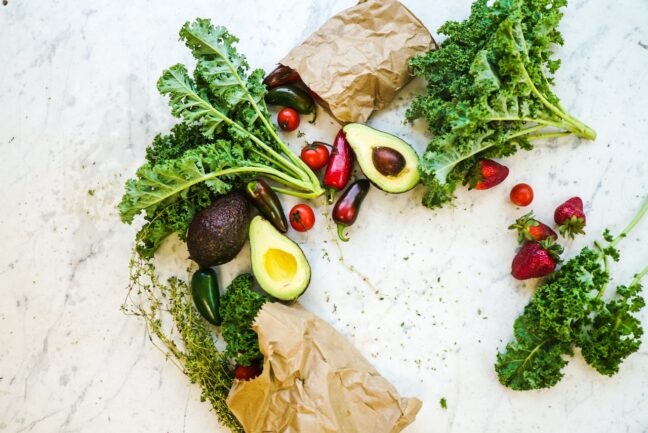It’s been a grey and rainy spring so far, but warmer weather is on the horizon! Whether you have a plant-based diet or not, chances are good that you want to eat more fruits and veggies. And considering that a recent CDC study showed that only about 1 in 10 adults consumes enough produce, it’s probably a good goal!
While changing your diet is always challenging, spring is an ideal time to try to add more fresh fruits and veggies to your diet because you will start seeing lots of fresh local produce! Here are some tips to help inspire you:
Salad Doesn’t Have to be Boring
When someone says “salad” you might think of a big bowl of lettuce leaves, but salads can be much more filling (and fun!) than that. Instead of thinking of salads as a side dish, consider making them the main meal: make sure you add some lean protein and healthy fats, and nearly any salad can become a filling meal that is still veggie-centric. In addition, don’t limit yourself to romain: consider thinly sliced crunchy vegetables like brussels sprouts, cabbage, carrots, or fennel. You can also add cooked veggies like leftover roasted potatoes or quickly blanched green beans or asparagus. Why not add fruit AND veggies in one meal by tossing your salad with fresh berries or a sliced apple?
As a bonus: when the weather starts getting hot, you’ll be thrilled to have a dinner that doesn’t heat up your house too much!
Have Fresh Fruit Prepared Ahead
If you’re looking for a quick snack, grabbing a bag of chips can seem a lot easier than washing, peeling, and cutting up fresh fruit. The solution? Prep your fruit as soon as you get home from the store!
This won’t work for all things—you probably don’t want to slice an apple days before you eat it—but you can wash them so that all you have to do is grab one. Same is true for berries and grapes. Othe fruit, like melons and kiwi, keep well after being sliced.
Put It Where You’ll See It
If you have trouble remembering to eat fruit and it’s not a habit yet, hiding it in your crisper drawer is like asking for it to go bad. Carve out some space on the fridge shelf you see most easily when you open the fridge, or free up a spot in the door for containers filled with fruit. Things like apples, bananas, and oranges will be fine at room temperature for several days, so keep a fruit bowl as a centerpiece on your kitchen counter or dining table. If you can see it, you’re more likely to remember it! (The other side of this is that you might want to put the chips and cookies out of sight.)
Go To a Farmers Market or Farm Stand
The growing season in New England is starting to kick off, which means that farmers markets and farm stands are starting to open. Making time every week to stop by and see what is fresh will help making fresh fruits and vegetables part of your routine. As a bonus, local fresh produce will be picked at its peak, and it can be really fun to see your ingredients change with the seasons.
Try a Plant-Based Dinner Exchange
If you like home cooked meals but get overwhelmed, consider banding together with a group of friends and setting up a dinner exchange. The concept: you cook a big batch of a plant-based meal that you love and package it up in freezer containers to distribute to everyone in the group. They do the same, so at the end of the day, if there are five people in the group, you have five plant-based meals in the freezer. As a bonus: share recipes with the food, and you can recreate your favorites on your own.
Start Small
Remember: building habits takes time. If you attempt a full makeover of your diet all at once, you are likely to get overwhelmed, exhausted, and dejected if it’s not working out. Maybe to start you go to the farmers market and pick out just one ingredient to add to your normal meals that week. Perhaps you make a goal to eat one serving of fruit a day. Small changes that you can maintain will help build your habits, making additional changes easier.
What are your favorite ideas for adding more fruits and vegetables to your diet? Tell us in the comments!

